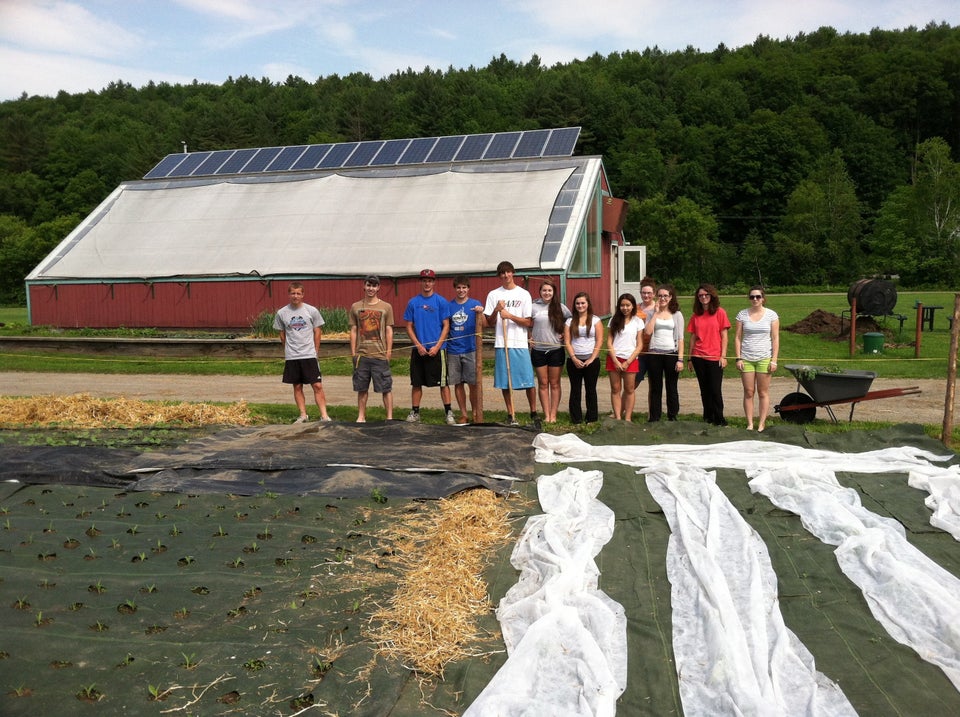
 By Anne Watson
By Anne Watson
Physics teacher, Montpelier High School.
As a physics teacher, I consider energy to be the most relevant topic in my curriculum. In 2005, when I was in my second year of teaching at Montpelier High School (MHS), a fellow science teacher encouraged me to work with students on finding a renewable energy source for our school's greenhouse, an amazing facility that is at the root of our school's commitment to sustainability. My students and I looked at data on the energy shed of this building and agreed that the school should install solar panels on the greenhouse. Over the next year we applied for and obtained grants needed for the 2.7kW grid-tied photovoltaic panel system which is currently operational.
But this is just one chapter in our greenhouse's success story. It is an integral part of our school and community. Every single student spends at least one biology unit growing salad greens that are served in the school's cafeteria. Students in Environmental Applications and Health classes prepare dishes using food grown in the greenhouse. And all of us are healthier eaters: Our data indicates a marked increase in "salad bar meals."
The MHS greenhouse is the work of my colleague Tom Sabo, the science teacher who encouraged me to do the energy study with my students. The idea was conceived in 2003. Recently, Tom and I chatted about school greenhouses, growing your own food, and teaching students to think sustainably.
Here is Part I of our conversation, on building the greenhouse.
Anne Watson: How does a school benefit from growing its own food?
Tom Sabo: There are many potential benefits depending on how it is done. Growing food can be a powerful learning experience, providing opportunities for critical thinking and problem solving. It's also ideal for making cross-disciplinary connections that bring relevance and give context to the subjects already being taught. And of course it generates nutritious whole food that students are more apt to try, given their involvement in its production.
AW: What was the vision behind our greenhouse?
TS: The original vision was to make MHS a "model of sustainability" while at the same time teaching about the concepts of sustainability. All too often we teach about the importance of something in the classroom, and then students leave the classroom to observe and experience contradictions in the daily operations of the school. Students will reason, if this stuff is so important, why isn't our school doing it?
AW: It's really important to involve students when launching this kind of project. How did you make sure you had student participation from the get-go?
TS: The original idea was conceived by a group of teachers. Student participation was guaranteed by making it part of the core curriculum, namely the required biology course. Many of the projects that grew out of our greenhouse food production efforts (i.e., the solar panels, additional crops grown in the surrounding gardens, the sub-irrigation system, the seed library) had greater student involvement in the design and implementation phases.
AW: Was it difficult to fundraise for this? How did you get started?
TS: It wasn't that difficult. Most of the initial funding came from small local grants. Once we were able to demonstrate success we were able to secure larger national grants. The areas of interest from a funder's perspective have ranged from environmental (reduction in carbon footprint, organic growing practices), to health and nutrition (combating teen obesity and Type 2 diabetes), to educational (relevant and rigorous Service Learning-based curriculum).
AW: If fundraising is not an option, how would a school go about starting on a garden or greenhouse?
TS: First you need permission to use a piece of school property. Ultimately you will want to amend the soil, which will cost a small amount of money. Compost is the way to go, both from a soil and monetary perspective. I have helped start numerous school gardens, and it can be done for as little as $250 (compost, seeds). Often schools like to construct raised beds for aesthetic reasons. This can be done for around $500. Greenhouses are more expensive with cost depending on size and style. Plastic hoop houses are the most economical.
AW: What were your worst mistakes in the beginning?
TS: Our biggest mistake was a compromise in the design due to budget limitations. We cut out a ridge vent that is important for passively cooling the greenhouse. If I could go back, I would change that.
AW: And best practices?
TS: Integrating the programming into our core curriculum. Serving the food in the school cafeteria. Connecting it with our composting program. Making it part of the culture of the school (i.e., Fall Harvest Celebration).
AW: Any other tips for teachers and students out there who want to get started on something like this?
TS: Backwards Design. Figure out what you are trying to accomplish then design the best program to achieve your goal(s). Plan for success then leverage that success to maximize the benefits of your program.
Anne Watson is a physics teacher at Montpelier High School in Montpelier, Vermont, and a Montpelier City Councilor. She is an alumna of the KSTF Teaching Fellowship.
